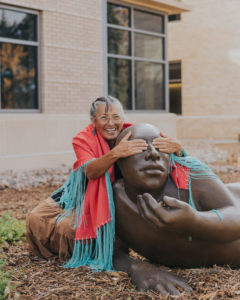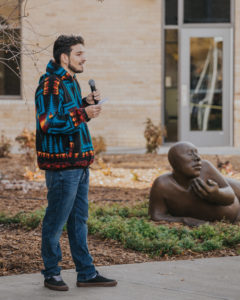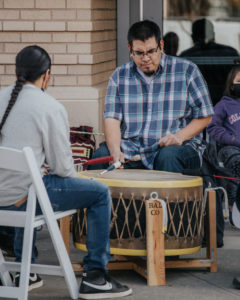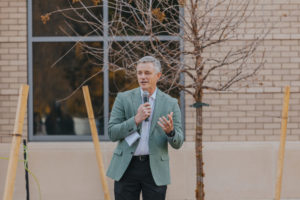
Roxanne Swentzell almost hit “delete.”
As she read through the request for proposal for a new sculpture in front of Colorado State University’s new Nutrien Agricultural Sciences Building, the sculptor was hesitant to apply.
“I couldn’t imagine what sculpture I could make that could grasp the enormity of the agricultural world,” said Swentzell, an acclaimed Santa Clara Tewa Native American artist and indigenous food activist. “My work in permaculture certainly taught me that growing crops and creating diverse ecosystems for the rest of my life would only teach me a minuscule of what there was to be learned in this field. I got dizzy thinking how big the topic gets really quickly.”
But then she asked herself a question: What are the very basics of good agriculture? Immediately, she thought of the strong bond between humans and plants — the feeling of watching flowers bloom, eating a ripe tomato straight from the garden and the way healthy soil looks, feels and smells.
And just like that, instead of “delete” Swentzell hit “send.”
Unveiling ‘Good Earth’
The result of that decision is Swentzell’s bronze sculpture “Good Earth.” Selected by CSU’s University Public Art Committee, the large-scale piece depicts a figure lying on the ground surrounded by greenery. An outstretched hand is lifted up to their face, which features a look of pure contentment as they smell a handful of rich soil.
Swentzell envisioned the piece as a reminder to all who pass by it to stay close to the Earth, showing it love through touch, smell, kind words and nurturing of the living organisms that make up healthy soil.
“I wanted it to be as close to the ground as possible, interacting with its natural environment, changing with the seasons and time,” she said. “I saw plants growing right up next to it, finding microclimates around legs and arms. Birds would sit, leaving streaks of nutrients on faded bronze patina until the rains would wash it into the Earth, feeding the wild grasses and flowers.”
It was also important to Swentzell that the figure be genderless and without a particular race so that it could convey a universal message.
“I wanted it to be anybody,” she said. “Any human person could look at it and have some kind of identity with it as a human being. Because I believe that’s where we need to go as a human species, to have a place where we can connect as a human race altogether.”
And while art often has an air of “don’t touch,” Swentzell said she feels the exact opposite about her sculptures.
“Please go touch the art,” she said. “Sit on it, play on it, tickle its feet, interact with it because part of the piece’s purpose is to be interrelated.”
Although the sculpture has been in front of the building for a few months, it wasn’t until last week that “Good Earth” was formally unveiled. The event at the sculpture’s new home in front of the Nutrien Building featured singing and drumming from the Iron Family Singers, as well as a reading by the college’s dean, James Pritchett, of CSU’s land acknowledgement. The acknowledgement recognizes the Indigenous peoples as original stewards of the land on which CSU operates, along with the University’s institutional history, responsibility and commitment to education and inclusion.
A sense of belonging
 Senior horticulture major Jason Valentine — who introduced Swentzell at the unveiling — said it’s inspiring to have artwork that was created by someone who is involved in agriculture. In addition to her art, Swentzell is a founder of the Flowering Tree Permaculture Institute, as well as editor of The Pueblo Food Experience Cookbook: Whole Food of Our Ancestors.
Senior horticulture major Jason Valentine — who introduced Swentzell at the unveiling — said it’s inspiring to have artwork that was created by someone who is involved in agriculture. In addition to her art, Swentzell is a founder of the Flowering Tree Permaculture Institute, as well as editor of The Pueblo Food Experience Cookbook: Whole Food of Our Ancestors.
But seeing Swentzell’s work every day will do more than connect him to his major, he said.
“As a Native American student, it gives me — and I think it will give a lot of future students — some sense of belonging and representation,” said Valentine, who is a member of the Osage Nation.
As an advocate for diverse voices, inclusivity and equity on campus, the college’s manager of student life and diversity, Elias Quiñonez, said the sculpture’s universal message is an important one.
“I really believe that the sculpture is going to be a constant reminder to those students with whom that message really resonates,” Quiñonez said. “And for the others who are still wondering and have questions of ‘what is that’ and ‘why is it here,’ I think it’s going to give them an opportunity to create discussion and dialogue around that. And that’s encouraging because I believe only growth and development can come from that.”
Bringing in Native American representatives from the campus to be part of the sculpture’s placement early on and making sure people felt heard was also a critical element in the process, he said.
“Too often in spaces — especially when we are either promoting or talking about other identities — we oftentimes can leave those voices out of it, and that’s a little bit dangerous,” he said. “And I really appreciate the fact that the college has been very intentional about this, to say, ‘What are the voices of this community?’”
A place for public art
The sculpture will be the perfect welcome for students and faculty to the new state-of-the-art teaching and research facility. In recognition of a $10 million transformational gift, the College of Agricultural Sciences’ Shepardson Building will be renamed the Nutrien Agricultural Sciences Building. The building is undergoing an extensive remodel of its 1938 structure, along with a 41,000-square-foot expansion with funds from the State of Colorado and CSU. The project is slated for a phased move-in beginning in early March.
“Good Earth” was selected as part of Colorado’s Art in Public Places program. By law, 1% of the state’s capital construction funds for new or renovated state buildings, like the Nutrien Building, must be allocated to pay for works of public art.
“Public art gives a richness to the campus experience that few other campus elements can provide,” said Fred Haberecht, co-chair of the University’s Public Art Committee. “A successful university campus draws the campus community and the visitor alike into its unique and authentic places, and provides an environment where a lifetime of memories can be had.”
These public art spaces tell a story about the history and values of our university, Haberecht said. They tell who we are as a university and as a society, and they serve a fundamental place-making role in the campus environment.
For Pritchett, the sculpture brings back memories of soil’s importance to him and his family growing up in rural southeastern Colorado.
“Sometimes, when the precipitation would come, you would reach down and you’d feel that soil and it would feel like clay and it would mold in your hands, and we would build things and imagine things with it,” he said. “And sometimes after the soil had been dry for a while, you’d pick it up and it would turn to dust and sprinkle away with the wind.”
No stranger to CSU
“Good Earth” is actually the third Roxanne Swentzell piece on CSU’s campus. The Gregory Allicar Museum of Art’s permanent collection includes Swentzell’s sculpture, “Mask Maker,” and her print “Rox’s World,” said museum Director and Chief Curator Lynn Boland.
“But to have something of this scale and in a public setting is so exciting,” Boland said. “It’s such a powerful work that will have an enormous impact.”
For Boland, who also is a member of the University Public Art Committee, the piece was a perfect fit for both the building and the campus.
“It makes a real statement about the University’s values and priorities as well as where CSU sees the future of everything, including its public art program,” he said.
For Swentzell, she said it was a joy to create the piece and to see it in its new home.
“As in all things, it now has a life of its own,” she said. “I have immense gratitude for being allowed to create this piece. May the love that sparked the idea of ‘Good Earth’ and the love that went into creating it spread throughout this institution and all who dared dream big enough to include earthworms in all the microbiome so that we might have continued life for future generations.”